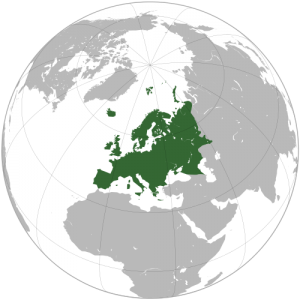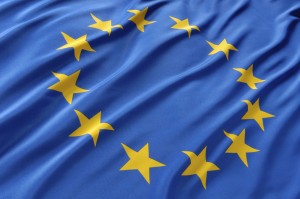 Population of Europe 2014
Population of Europe 2014
Based on the population growth between 2012 and 2013 and the population of Europe in 2013, the population of Europe in 2014 is estimated to be about 741.2 million people, which is the third most populous continent behind Asia and Africa. Overall, there are fifty-six states that are considered to be in the boundaries of the European continent. However, six of these states have limited recognition, but the other fifty states are internationally recognized. Despite sharing territory with Asia, the Russian Federation has the largest population in Europe. The country with the largest population solely in Europe is the Federal Republic of Germany. The country (internationally recognized) with the smallest population in Europe is the Holy See, otherwise known as Vatican City. The Holy See only has around 850 people. It also has the least total area, less than half a mile of square miles. Other than the Russian Federation, the Republic of Kazakhstan has the most total area of all European nations.
Religion in Europe 2014
The main religion throughout Europe is considered to be Christianity. However, Christianity is made up of various sects, but the three major sects are Roman Catholicism, Protestantism, and Orthodoxy. Roman Catholicism is much more prominent and widely practiced in Western and Southern Europe. The Holy See, the home of the Roman Catholic Pope, is located in Rome, Italy, which is a part of Southern Europe. Spain and Portugal are also known to be very Catholic countries as well. Northern Europe more frequently practices Protestantism and Eastern Europe more so practices Orthodoxy. Russian and Greek Orthodox are two of the most largely practiced Orthodox religions. A survey taken in 2012 indicated that 72% of the European Union reports that Christianity is the largest religion in their respective nation. However, because Turkey is a part of Europe and over 98% of Turks practice Islam, Islam has a presence in Europe as well. Lastly, Judaism only has a small population, and France has the largest Jewish community, despite their reputation for being fairly irreligious.
Geography of Europe 2014
Europe is bordered by the Arctic Ocean on the north, the Atlantic Ocean on the west, and the Mediterranean, Black, and Caspian Seas on the south. Europe consists of two countries that share its land with another continent: Russia and Turkey. The European portion of Russia is all of the land to the west of the Ural Mountains. The European portion of Turkey consists of the land to the west of the Sea of Marmara, the Dardanelles, and the Bosphorus. Also, Europe does not include the majority of Anatolia.
The longest river in all of Europe is the Volga River, which is about 2,290 miles long. The shortest river in Europe is the Morava River, which is about 219 miles long. The largest landscape feature of Europe is considered to be the East European Plain. It is the largest non-mountainous part of the continent and is made up of river basins throughout Eastern Europe. Another large geographical feature of Europe is the Messeta Central, which is a plateau region that makes up about 40% of Spain. Some of the major mountain ranges are the Ural Mountains, which separate Europe and Asia, the Caucasus Mountains, which also separate Europe and Asia, the Pyrenees, which separates France and Spain, and the Alps, which run across Central Western Europe. There are only seventeen nations in the continent that are landlocked. The other countries touch at least one body of water.
European Wildlife 2014
One of the main animals that existed in Europe, but is now extinct, is the wooly mammoth, which became extinct before the Neolithic period. Some other extinct animals include the dwarf hippopotamus and the dwarf elephants. Early human settlement in the region caused the extinction of these animals. Presently, though endangered, bears and wolves are found throughout Europe. The Brown Bear, the largest predator in Europe, is mainly found in the Balkan Peninsula, Russia, and Scandinavia. The second largest predator in Europe is the wolf, which mainly live in the Balkan Peninsula and Eastern Europe. Some other animals found throughout Europe are wild cats, foxes, jackals, vipers, grass snakes, and martens. Lastly, some important sea animals in Europe are the zooplankton, echinoderms, squids, octopuses, and dolphins.
 European Union 2014
European Union 2014
The European Union is an organization of twenty-eight sovereign states within the European continent. The following countries are members of the European Union: Austria, Belgium, Bulgaria, Croatia, Cyprus, Czech Republic, Denmark, Estonia, Finland, France, Germany, Greece, Hungary, Ireland, Italy, Latvia, Lithuania, Luxembourg, Malta, Netherlands, Poland, Portugal, Romania, Slovakia, Slovenia, Spain, Sweden, and the United Kingdom. The membership spans over 1,707,787 square miles of land across the continent. The Union makes up over 500 million people, which accounts for over 7% of the world’s population. It was established in order to help economic and social development, protect the freedoms and rights of all of its members, and to help promote European identity on an international level. In an attempt to further promote these objectives, the European Union has established a single currency, known as the euro.
The area of the continent that uses the euro is known as the eurozone, which consists of eighteen countries. Latvia was the most recent country to join the eurozone on January 1, 2014. The only European Union members that are not legally obligated to join the eurozone are Denmark and the United Kingdom. The purpose of the creation of the eurozone was to lessen the number of problems with exchange rates, interest rates, price stability, and to help make it easier for traveling citizens. All of the banks and financial institutions in the eurozone are under the direction and control of the European Central Bank, the main bank of the eurozone.
The European Union does not have too much control over education and science. However, the Erasmus Programme, established in 1987, is a program designed to allow international exchange for college students to be an easy process. There are international programs for teachers and those in vocational education training courses in order to help better educate the population.
There are twenty-four official and working languages among the European Union: Bulgarian, Croatian, Czech, Danish, Dutch, English, Estonian, Finnish, French, German, Greek, Hungarian, Italian, Irish, Latvian, Lithuanian, Maltese, Polish, Portuguese, Romanian, Slovak, Slovene, Spanish, and Swedish. The most widely spoken languages in the European Union are English (51%), German (27%), French (24%), Italian (16%), and Spanish, (15%). In fact, about 56% of the population can engage in conversation in a language other than their native language. Also, the European Union has no specific religious affiliation and is considered to be a secular organization. However, among those in the European Union, Roman Catholicism is the most widely practiced religion; about 48% of the population practices it. The next largest religious affiliation is atheism and agnosticism, which is about 23% of the population. Only 2% of the population practices Islam.
European Population Decline


